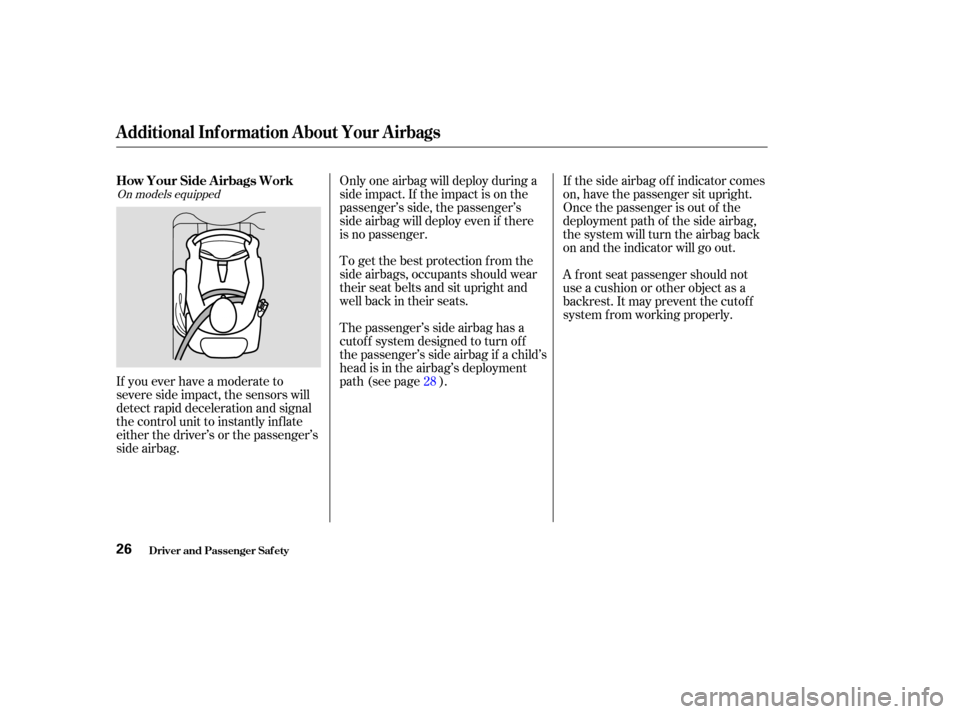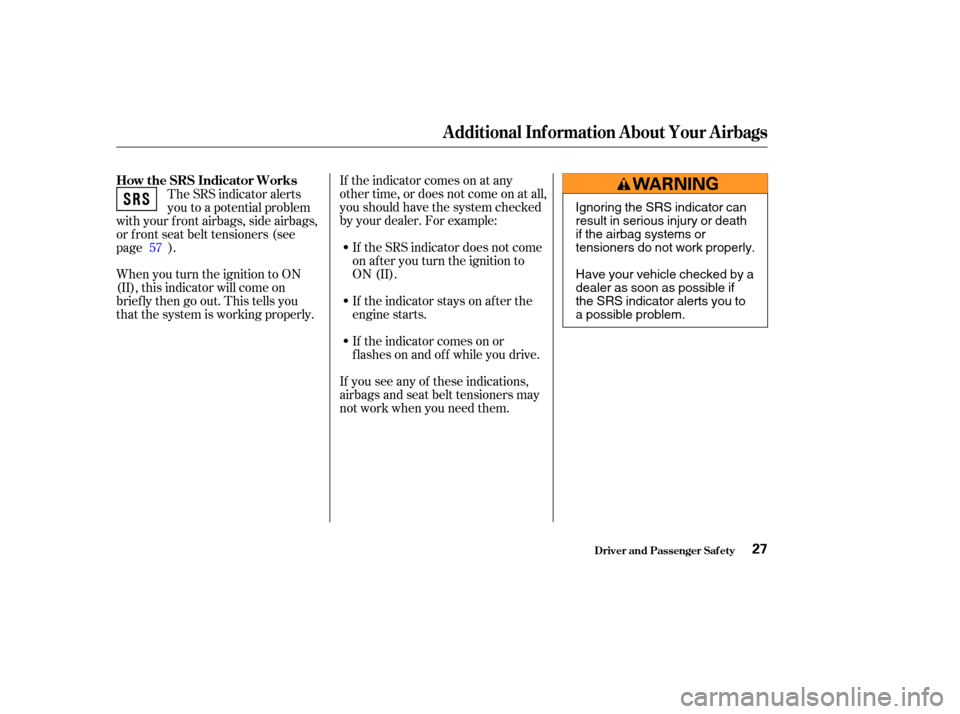Page 30 of 256

On models equipped
If you ever have a moderate to
severe side impact, the sensors will
detect rapid deceleration and signal
the control unit to instantly inf late
either the driver’s or the passenger’s
side airbag.Only one airbag will deploy during a
side impact. If the impact is on the
passenger’s side, the passenger’s
side airbag will deploy even if there
is no passenger.
To get the best protection f rom the
side airbags, occupants should wear
their seat belts and sit upright and
well back in their seats.
The passenger’s side airbag has a
cutof f system designed to turn of f
the passenger’s side airbag if a child’s
head is in the airbag’s deployment
path (see page ).
If the side airbag of f indicator comes
on, have the passenger sit upright.
Once the passenger is out of the
deployment path of the side airbag,
the system will turn the airbag back
on and the indicator will go out.
A f ront seat passenger should not
use a cushion or other object as a
backrest. It may prevent the cutof f
system f rom working properly.
28
How Your Side A irbags Work
Additional Inf ormation About Your Airbags
Driver and Passenger Saf ety26
Page 31 of 256

If you see any of these indications,
airbags and seat belt tensioners may
not work when you need them. If the indicator comes on at any
other time, or does not come on at all,
you should have the system checked
by your dealer. For example:If the SRS indicator does not come
on after you turn the ignition to
ON (II).
If the indicator stays on after the
engine starts.
If the indicator comes on or
flashesonandoff whileyoudrive.
The SRS indicator alerts
you to a potential problem
with your f ront airbags, side airbags,
or f ront seat belt tensioners (see
page ).
When you turn the ignition to ON
(II), this indicator will come on
brief ly then go out. This tells you
that the system is working properly. 57
Additional Inf ormation About Your Airbags
Driver and Passenger Saf ety
How the SRS Indicator Works
27
Ignoring the SRS indicator can
result in serious injury or death
if the airbag systems or
tensioners do not work properly.
Have your vehicle checked by a
dealer as soon as possible if
the SRS indicator alerts you to
a possible problem.
Page 32 of 256

On models equipped
To reduce the risk of injury f rom an
inf lating side airbag, your vehicle has
an automatic cutoff system for the
passenger’s side airbag.
Although Honda does not encourage
children to ride in f ront, this system
is designed to shut of f the side
airbag if a child leans sideways and
the child’s head is in the side airbag
deployment path.If a short adult leans sideways, or a
larger adult slouches and leans
sideways into deployment path, the
system may also shut of f the side
airbag.
Your airbag systems are virtually
maintenance-f ree, and there are no
parts you can saf ely service.
However, you must have your
vehicle serviced if:
Any airbag
that has deployed must be
replaced along with the control
unit and other related parts. If a
f ront airbag inf lates, the seat belt
tensioners must also be replaced.
Do not try to remove or replace
anyairbagbyyourself.Thismust
be done by a Honda dealer or a
knowledgeable body shop.
This indicator alerts you
that the passenger’s side
airbag has been automatically shut
of f . It does mean there is a
problem with your side airbags. When you turn the ignition switch to
ON (II), the indicator should light
brief ly and go out. If it doesn’t light,
stays on, or comes on while driving
without a passenger in the f ront seat,
have the system checked.
Take your vehicle to an
authorized Honda dealer as soon
as possible. If you ignore this
indication, your airbags may not
operate properly.
Additional Inf ormation About Your Airbags
Driver and Passenger Saf ety
Airbag Service
How the Side Airbag Of f
Indicator Works
An airbag ever inf lates.
not
T he SRS indicat or alert s you t o aproblem.
28
Page 33 of 256
Together, airbags and
seat belts provide the best
protection.
Tampering could cause
the airbags to deploy, possibly
causing very serious injury.
If water or another liquid
soaks into a seat-back, it can
prevent the side airbag cutof f
system f rom working properly. Improperly
replacing or covering f ront seat-
back covers can prevent your side
airbags f rom inf lating during a
side impact.
Additional Saf ety Precautions
Donotattempttodeactivateyour
airbags.
Do not t amper wit h airbagcomponent s or wiring f or anyreason.
Do not expose t he f ront seat -backsto liquid. Do not cover or replace f ront seat -
back covers wit hout consult ing aHonda dealer.
Additional Inf ormation About Your Airbags
Driver and Passenger Saf ety29
Page 35 of 256

�µ�µ
�µ
(see pages ).(see pages ). According to accident statistics,
children of all ages and sizes are
saf er when they are restrained in the
back seat. The National Highway
Traf f ic Saf ety Administration and
Transport Canada recommend that
all children age 12 and under be
properly restrained in the back seat.
Children who ride in back are less
likely to be injured by striking
interior vehicle parts during a
collision or hard braking. Also,
children cannot be injured by an
inf lating airbag when they ride in the
back. Front airbags have been designed to
help protect adults in a moderate to
severe f rontal collision. To do this
the passenger’s f ront airbag is quite
large and it can inf late with enough
f orce to cause very serious injuries.
4636
4946
CONT INUED
Inf ant s and small children must berest rained in an approved child seatt hat is properly secured t o t hevehicle
Larger children must be restrainedwit h a lap/shoulder belt and ride ona boost er unt il t he seat belt f it s t hemproperlyAll Children Should Sit in the
Back Seat The Passenger’s Front Airbag
Poses Serious Risks
Driver and Passenger Saf ety
Protecting Children General Guidelines
31
Page 36 of 256

�µ
If
the airbag inf lates, it can hit the back
of the child seat with enough force
to kill or very seriously injure an
inf ant. Whenever possible,
larger children should sit in the back
seat, in a booster seat if needed, and
be properly restrained with a seat
belt (see page f or important
inf ormation about protecting larger
children).
If the vehicle seat is
too far forward, or the child’s head is
thrown f orward during a collision, an
inflating front airbag can strike the
child with enough f orce to kill or
very seriously injure small child. 46
Inf ant s
Never put a rear-f acing child seat int he f ront seat of a vehicle equippedwit h a passenger’s f ront airbag. Small Children
Larger Children
Children who have outgrown childseat s are also at risk of being injuredor killed by an inf lat ing passenger’sfront airbag.
Placing a f orward-f acing child seat in
t he f ront seat of a vehicle equippedwit h a passenger’s f ront airbag canbe hazardous.
Driver and Passenger Saf ety
Protecting Children General Guidelines
32
Page 37 of 256
�µ
To remind you of the passenger’s
f ront airbag hazards, and that
children must be properly restrained
in the back seat, your vehicle has
warninglabelsonthedashboardand
on the driver’s and f ront passenger’s
visors. Please read and f ollow the
instructions on these labels.To remind you of the f ront airbag
hazards, your vehicle has warning
labels on the driver’s and f ront
passenger’s visors. Please read and
f ollow the instructions on these
labels.
U.S. Models
Canadian Models
Driver and Passenger Saf ety
Protecting Children General Guidelines
33
Page 38 of 256

�µ
Your vehicle has three seating
positions in the back seat where
children can be properly restrained.
If your ever have to carry a group of
children, and a child must ride in
front:Place the largest child in the f ront
seat, provided the child is large
enough to wear the lap/shoulder
belt properly (see page ).
Move the vehicle seat as far to the
rear as possible (see page ).
Have the child sit upright and well
backintheseat(seepage ).
Make sure the seat belt is properly
positioned and secured (see page ). Many parents say they pref er to put
an inf ant or small child in the f ront
passenger seat so they can watch the
child, or because the child requires
attention.
Neverholdaninfantorchildon
your lap. If you are not wearing a
seat belt in crash, you could be
thrown forward and crash the
child against the dashboard or a
seat-back. If you are wearing a
seat belt the child can be torn
from your arms and be seriously
hurt or killed.
Never put a seat belt over yourself
or a child. During a crash, the belt
could press deep into the child and
cause serious or f atal injuries.
Never let two children use the
same seat belt. If they do, they
could be very seriously injured in a
crash.
Placing a child in the f ront seat
exposes the child to hazards f rom
the passenger’s f ront airbag, and
paying close attention to a child
distracts the driver f rom the
important tasks of driving, placing
both of you at risk.
If a child requires close physical
attention or f requent visual contact,
we strongly recommend that another
adult ride with the child in the back
seat. The back seat is far safer for a
child than the front.
46
1231
15
If You Must Drive with Several
Children
If a Child Requires Close
AttentionAdditional Saf ety Precautions
Driver and Passenger Saf ety
Protecting Children General Guidelines
34